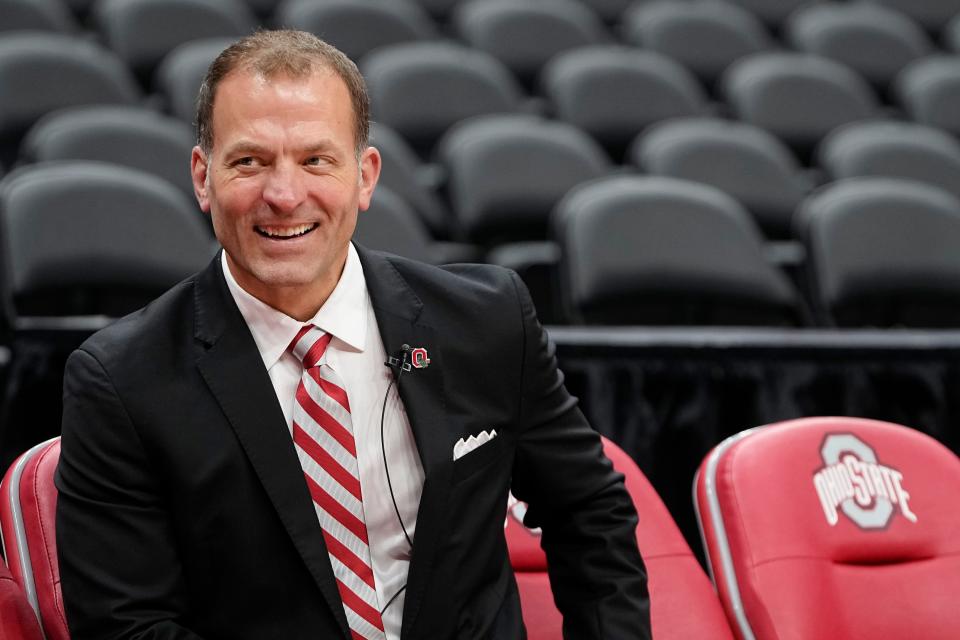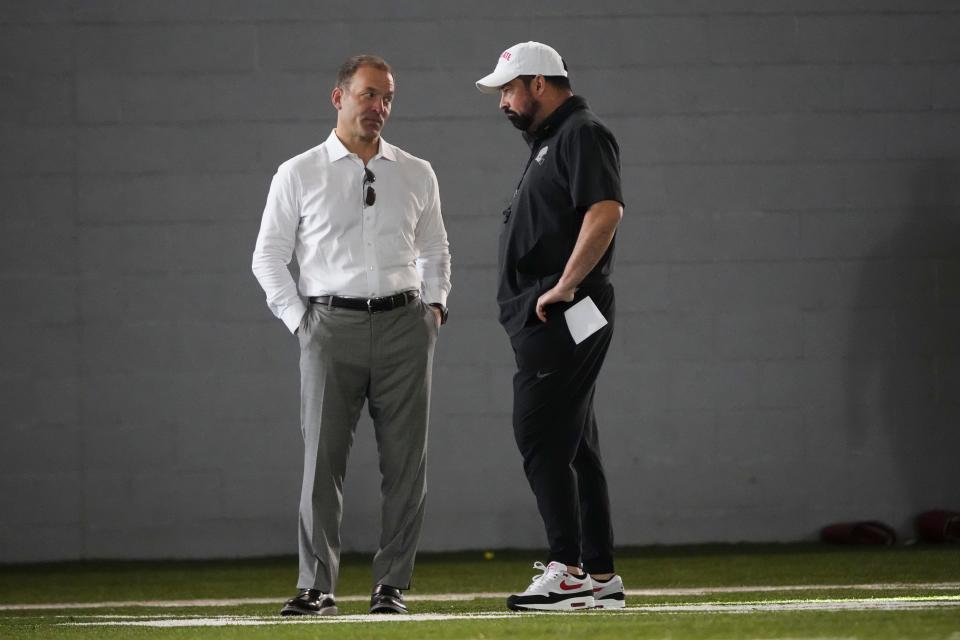How Ross Bjork prepared to take over as Ohio State athletic director
When Ohio State hired Ross Bjork in January, it laid the groundwork for a smooth succession.
The timing allowed Bjork to join the athletic department in March, spending four months as a senior advisor to Gene Smith, the longtime athletic director who retired last weekend.
“It was a great opportunity to get to know the people and the place without worrying about the day-to-day operations," Bjork said.
Bjork has worked in athletics administration for nearly three decades, beginning in the development office at Western Kentucky. And while his first few months in Columbus might have marked a relatively quiet stretch in his career, there were exceptions: The school fired men’s basketball coach Chris Holtmann and softball coach Kelly Kovach Schoenly. Baseball coach Bill Mosiello and rowing coach Kate Sweeney resigned. It left Bjork to conduct searches for their replacements.

He spent most of his time preparing to fill the top position of one of the largest athletic departments in the nation, the 51-year-old taking the opportunity to acclimate to Ohio State.
He met with senior administrators and coaches and gathered with the various offices within the department for town halls, soliciting advice and seeking various perspectives. He toured nearly two dozen facilities.
“Trying to learn through the connections with the people, connections with the place,” Bjork said.
It was a blueprint he followed when he took over as the athletic director at past schools.

“The situations and fundamentals are about the same no matter what campus you’re on,” Bjork said. “You’re dealing with very similar issues. But the scale is magnified here.”
Ohio State’s athletic department includes more than 600 employees. Bjork estimated the department, including business advancement, is about twice the size of the one he led for the past four years at Texas A&M.
The Buckeyes sponsor 36 varsity sports teams, tied with Stanford for the most among power conference schools.
“This is a massive place,” Bjork said. “You can’t bite it off in four months. It’s going to take however long that takes to continue to learn.”
But Bjork, who was formally elevated to athletic director on Monday, faces pressing issues in the months ahead. Perhaps none is as potentially significant as preparations for the prospect of revenue sharing with athletes.
When the NCAA reached a legal settlement of three antitrust cases in May, it established the framework for schools to share millions of dollars in revenues from their media rights deals, sponsorships and ticket sales.
If a federal judge OKs the agreement, the Buckeyes plan to provide athletes with the maximum total allotment, a figure adding up to at least $20 million annually. It would take effect starting with the 2025-26 academic year.
“That is going to be a priority,” Bjork said.

The direct payments are expected to not only add a significant expense for the department, which operated at a deficit during the last fiscal year, but also prompt administrators to sort out an array of complex issues over how to divide up the money.
Bjork anticipates that payments will need to be proportional between male and female athletes due to Title IX, the federal law requiring gender equity within college sports, though legal assessments will continue over the next year.
To cover the rising costs and recover from a budget shortfall estimated to be at least $10 million, Bjork sees generating revenue as an even more critical function and expects the department to seek new sources of revenue, especially as they continue to keep all 36 sports.
One idea Bjork suggested is the addition of a premium services club at Ohio Stadium that could be open throughout the year. The Buckeyes are also selling tickets to four football practices during preseason training camp in August.
“Every piece has to be looked at,” Bjork said. “How do you monetize that?
More: Join the Ohio State Sports Insider text group with Bill Rabinowitz, Joey Kaufman Adam Jardy
Bjork plans to begin traditional fundraising this year as well. Most of his interactions with donors in previous months were limited to prearranged events or social media. In his formal capacity as athletic director, he will begin meeting them individually.
“The role of the modern-day athletic director, and even 20 years ago, has always been relationship building,” Bjork said, “being visible in the community, not because you’re the most important person, but because they need to hear from leadership.”
Some of those gatherings will involve raising money for capital expenditures, including a significant renovation and expansion of the Woody Hayes Athletic Center.
At the university’s board of trustees meeting in May, Bjork and Smith informed a committee of plans to begin a quiet phase of a new capital campaign aiming to raise millions to overhaul the football facility, which opened almost four decades ago.
In the arms race in college athletics, spending on facilities has been a constant. The Buckeyes refurbished their locker room this past spring and dedicated $7.8 million for upgrades that were completed as recently as 2019 that included a new nutrition area and players’ lounge.
Renovations were often designed to appeal to recruits, but Ohio State’s latest rebuild is driven by a particularly practical purpose.
“We’re out of space,” Bjork said.
Bjork pointed out the auditorium for team meetings is unable to seat all of the players and personnel and that other meeting rooms are cramped. Smith also raised the limited spacing as an issue last year.
The need for a bigger footprint for the building, which is in position to stretch farther east toward Olentangy River Road, is a product of the continued growth of the program’s support staff, a broad group that includes a mix of analysts, quality control coaches, talent evaluators, nutritionists and others.
The cost for the project is undetermined, but Bjork estimated it will range between $150 million and $200 million, requiring him to target large-scale donors.
“We want to go fast,” Bjork said. “We want to capture momentum we have right now. We want to go through the summer and fall and have these really high-level conversations with our lead gift prospects. We’re teeing all of that up right now.”
The total raised off the bat is likely to shape a formal proposal and the timeline for any groundbreaking, construction and completion.
Logistics could complicate the schedule, as well.
“You’re going to tear down some parts of the building to add new square footage and you’re going to renovate existing space, but people still have to keep working,” Bjork said. “Football programs are not going to shut down.
“We’re studying the movement of that. Do you move everybody out of the building and renovate and expand at once? Where do they go? Do you keep everybody in the building while you’re doing one section? And when that’s done, you move into that section, and then do this section? That makes the timeline longer.”
Bjork identified the OSU Ice Rink, which houses the national champion women’s ice hockey team, as another facility in need of a facelift. He noted its age (it opened in 1961) and small capacity (it seats fewer than a thousand fans).
While the men’s hockey team plays at the larger Schottenstein Center, Bjork said they are examining potential options for both programs.
As he settles in, Bjork has no plans to overhaul the department’s staff. He said there are no key openings and does not anticipate turnover. No one from his previous roles has followed him to Columbus.
“There’s not a Bjork SWAT Team coming in to save the day,” he said. “We don’t need that. The culture's defined. The staff is great. Will there be tweaks and analysis? Sure. There has to be eventually. But that's not the objective. The objective is to grow upon what we have.”
One area that could be bolstered is fundraising. Bjork proposed the Buckeyes could benefit from more fundraisers.
“They can generate more money,” he said.
Throughout his administrative career, Bjork built a reputation as a prodigious fundraiser.
When he left Texas A&M earlier this year, the school was in the middle of a $270 million spending campaign. It included a new indoor football practice facility and additional suites at Kyle Field, its mammoth football stadium. In his previous stop at Mississippi, he oversaw the construction of a $96.5 million basketball arena that opened in 2016 and $65 million in renovations to the football stadium, among other projects. Even before he first became an athletic director at Western Kentucky, he led the campaign to raise funds to renovate UCLA's historic Pauley Pavilion as part of the Bruins' administrative staff.
“Everywhere I've been, we've had needs for projects,” Bjork said, “so I've kind of been in the right place.”
In little more than a month, Bjork will be at Ohio State’s stadiums to attend games and practices. The men's and women's soccer and field hockey teams begin their seasons in August.
Football opens on Aug. 31, and the Buckeyes hold their three nonconference games at Ohio Stadium before opening their Big Ten schedule at Michigan State in Sept. 28.
“Getting to understand the infrastructure and more of the day-to-day operations will become a priority,” Bjork said.
Bjork’s plans at Ohio State are likewise ambitious, befitting a vast athletic department. But as he assumes the helm, he also aims to keep a steady pace in the months ahead.
“The thing I have to remember, that we all have to remember, is that this is a marathon, not a sprint,” he said, "We’re not going to have it figured out by July 15. We’re not going to have it figured out by Oct. 1. There are going to be segments and continued relationship building.”
Joey Kaufman covers Ohio State football for The Columbus Dispatch and can be reached at jkaufman@dispatch.com.
Get more Ohio State football news by listening to our podcasts
This article originally appeared on The Columbus Dispatch: How Ross Bjork prepared to take over as Ohio State athletic director

